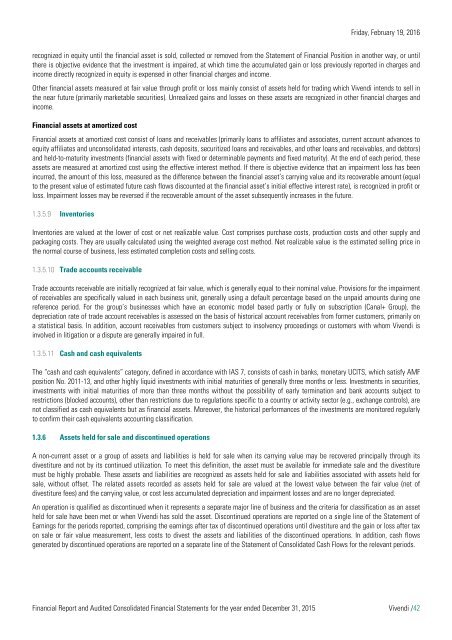1owHYXa
1owHYXa
1owHYXa
Create successful ePaper yourself
Turn your PDF publications into a flip-book with our unique Google optimized e-Paper software.
Friday, February 19, 2016<br />
recognized in equity until the financial asset is sold, collected or removed from the Statement of Financial Position in another way, or until<br />
there is objective evidence that the investment is impaired, at which time the accumulated gain or loss previously reported in charges and<br />
income directly recognized in equity is expensed in other financial charges and income.<br />
Other financial assets measured at fair value through profit or loss mainly consist of assets held for trading which Vivendi intends to sell in<br />
the near future (primarily marketable securities). Unrealized gains and losses on these assets are recognized in other financial charges and<br />
income.<br />
Financial assets at amortized cost<br />
Financial assets at amortized cost consist of loans and receivables (primarily loans to affiliates and associates, current account advances to<br />
equity affiliates and unconsolidated interests, cash deposits, securitized loans and receivables, and other loans and receivables, and debtors)<br />
and held-to-maturity investments (financial assets with fixed or determinable payments and fixed maturity). At the end of each period, these<br />
assets are measured at amortized cost using the effective interest method. If there is objective evidence that an impairment loss has been<br />
incurred, the amount of this loss, measured as the difference between the financial asset’s carrying value and its recoverable amount (equal<br />
to the present value of estimated future cash flows discounted at the financial asset’s initial effective interest rate), is recognized in profit or<br />
loss. Impairment losses may be reversed if the recoverable amount of the asset subsequently increases in the future.<br />
1.3.5.9 Inventories<br />
Inventories are valued at the lower of cost or net realizable value. Cost comprises purchase costs, production costs and other supply and<br />
packaging costs. They are usually calculated using the weighted average cost method. Net realizable value is the estimated selling price in<br />
the normal course of business, less estimated completion costs and selling costs.<br />
1.3.5.10 Trade accounts receivable<br />
Trade accounts receivable are initially recognized at fair value, which is generally equal to their nominal value. Provisions for the impairment<br />
of receivables are specifically valued in each business unit, generally using a default percentage based on the unpaid amounts during one<br />
reference period. For the group’s businesses which have an economic model based partly or fully on subscription (Canal+ Group), the<br />
depreciation rate of trade account receivables is assessed on the basis of historical account receivables from former customers, primarily on<br />
a statistical basis. In addition, account receivables from customers subject to insolvency proceedings or customers with whom Vivendi is<br />
involved in litigation or a dispute are generally impaired in full.<br />
1.3.5.11 Cash and cash equivalents<br />
The “cash and cash equivalents” category, defined in accordance with IAS 7, consists of cash in banks, monetary UCITS, which satisfy AMF<br />
position No. 2011-13, and other highly liquid investments with initial maturities of generally three months or less. Investments in securities,<br />
investments with initial maturities of more than three months without the possibility of early termination and bank accounts subject to<br />
restrictions (blocked accounts), other than restrictions due to regulations specific to a country or activity sector (e.g., exchange controls), are<br />
not classified as cash equivalents but as financial assets. Moreover, the historical performances of the investments are monitored regularly<br />
to confirm their cash equivalents accounting classification.<br />
1.3.6 Assets held for sale and discontinued operations<br />
A non-current asset or a group of assets and liabilities is held for sale when its carrying value may be recovered principally through its<br />
divestiture and not by its continued utilization. To meet this definition, the asset must be available for immediate sale and the divestiture<br />
must be highly probable. These assets and liabilities are recognized as assets held for sale and liabilities associated with assets held for<br />
sale, without offset. The related assets recorded as assets held for sale are valued at the lowest value between the fair value (net of<br />
divestiture fees) and the carrying value, or cost less accumulated depreciation and impairment losses and are no longer depreciated.<br />
An operation is qualified as discontinued when it represents a separate major line of business and the criteria for classification as an asset<br />
held for sale have been met or when Vivendi has sold the asset. Discontinued operations are reported on a single line of the Statement of<br />
Earnings for the periods reported, comprising the earnings after tax of discontinued operations until divestiture and the gain or loss after tax<br />
on sale or fair value measurement, less costs to divest the assets and liabilities of the discontinued operations. In addition, cash flows<br />
generated by discontinued operations are reported on a separate line of the Statement of Consolidated Cash Flows for the relevant periods.<br />
Financial Report and Audited Consolidated Financial Statements for the year ended December 31, 2015 Vivendi /42


